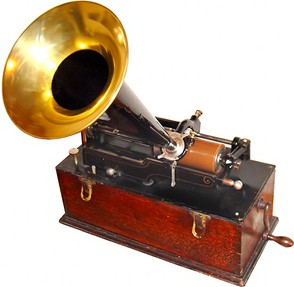Whilst working on his inventions, the telephone and the telegraph,Thomas Edison discovered that messages could be transmitted onto paper by indentations made by sound vibrations. Later he used a metal cylinder wrapped round with tin foil. When he spoke into a mouthpiece, a needle would indent the vibrations onto the cylinder in a groove pattern. And, working with his mechanic, John Druesi, a machine was built in 1877 with a second needle which played back the recorded words. A patent was issued in 1878.
Whilst Edison then began to concentrate on developing the incandescent light bulb (sales of which are only in 2011 being banned in the UK), Alexander Graham Bell used his prize money, derived from inventing the telephone, to develop accoustical and electrical research with Chichester A Bell and Charles Sumner Tainter. Improvements were made on the phonograph using wax instead of tinfoil, and using a floating stylus which would cut rather than indent the cylinder, and this was patented in 1886 and called a graphophone. Edison refused to collaborate with them and himself made similar improvements on his own machine, named the New Phonograph.
Edison started the National Phonograph Company to manufacture his phonograph for home entertainment, and branches were set up in Europe within three years. His Spring Motor Phonograph appeared in 1896 and then his Edison Home Phonograph, followed in 1898  by the Edison Standard Phonograph (see photograph on the left), the first to bear his trademark design. Mass production reduced the price from $150 in 1891 to $20 for his Standard model and only $7.50 for the Gem, produced in 1899
by the Edison Standard Phonograph (see photograph on the left), the first to bear his trademark design. Mass production reduced the price from $150 in 1891 to $20 for his Standard model and only $7.50 for the Gem, produced in 1899
The cylinders cost 50 cents and normally played at 120 r.p.m., featuring music and speech, but they only lasted about 2 minutes, which was limiting, and, as there was no duplication process, performers would need to keep repeating their offerings for marketing.
The louder Edison Concert Phonograph with a bigger cylinder came out in 1899, costing $125, with the cylinders $4 but was unpopular and went out of production in 1912 in spite of a large price reduction.
By 1901 cylinders could be mass produced, being molded, using a harder black wax, rather than engraved, and up to 150 cylinders could be produced from a single mold. By 1904 this was reflected in the reduced price of 35 cents each. In 1905 a new and improved Edison business phonograph system was brought out which was less fragile and easier to use, but still more costly than Columbia Dictaphones. It consisted of a dictating machine, a separate transcribing machine and a shaving machine to recycle used cylinders. The improved Ediphone came out in 1916 with increasing sales through the 1920’s.
 The Amberola I phonograph came out in 1909, a luxury floor model with better performance, to compete with Columbia's Grafonola (see photograph on the left) and the Victrola.
The Amberola I phonograph came out in 1909, a luxury floor model with better performance, to compete with Columbia's Grafonola (see photograph on the left) and the Victrola.
The Company became Thomas A Edison in 1910 and Edison’s son was also involved. Its main competitors, Columbia and The United States Phonograph Co. had both given up cylinder production by 1913. The disc grew more popular, but the cylinder continued, and Edison brought out an unbreakable cylinder, the Blue Amberol Record which had the best sound to date. But cylinders became increasingly unpopular and in 1913 Edison brought out the Edison Disc Phonograph, whilst continuing with the Blue Amberold cylinders, until the Company closed in 1929.
Acknowledgments: Top Picture - Edison Standard Phonograph
Second picture: Columbia Grafanola, both by Shenandoah Restoration
The information in this article was derived from a longer article The History of the Edison Phonograph


 by the Edison Standard Phonograph (see photograph on the left), the first to bear his trademark design. Mass production reduced the price from $150 in 1891 to $20 for his Standard model and only $7.50 for the Gem, produced in 1899
by the Edison Standard Phonograph (see photograph on the left), the first to bear his trademark design. Mass production reduced the price from $150 in 1891 to $20 for his Standard model and only $7.50 for the Gem, produced in 1899 The Amberola I phonograph came out in 1909, a luxury floor model with better performance, to compete with Columbia's Grafonola (see photograph on the left) and the Victrola.
The Amberola I phonograph came out in 1909, a luxury floor model with better performance, to compete with Columbia's Grafonola (see photograph on the left) and the Victrola.


























 Don't Call it Failure, Call it Practice - a Self-Help Guide to Successon 02/10/2012
Don't Call it Failure, Call it Practice - a Self-Help Guide to Successon 02/10/2012



Please Leave Comments Here - I love to hear from people from all round the world
Fascinating! I remember the old gramophone my father loved - it actually worked pretty well! Love your Nipper ornament!
Awesome collectibles, I like them! I remember my grandparents having a similar old phonogram. They used to take care of it as if it were gold :)
Very interesting page. I love the old photos!
Enjoyed the article...I have always enjoyed recordings and miss the old phonographs...still have one that works and all of my 33s...enjoy listening to them on occasion.